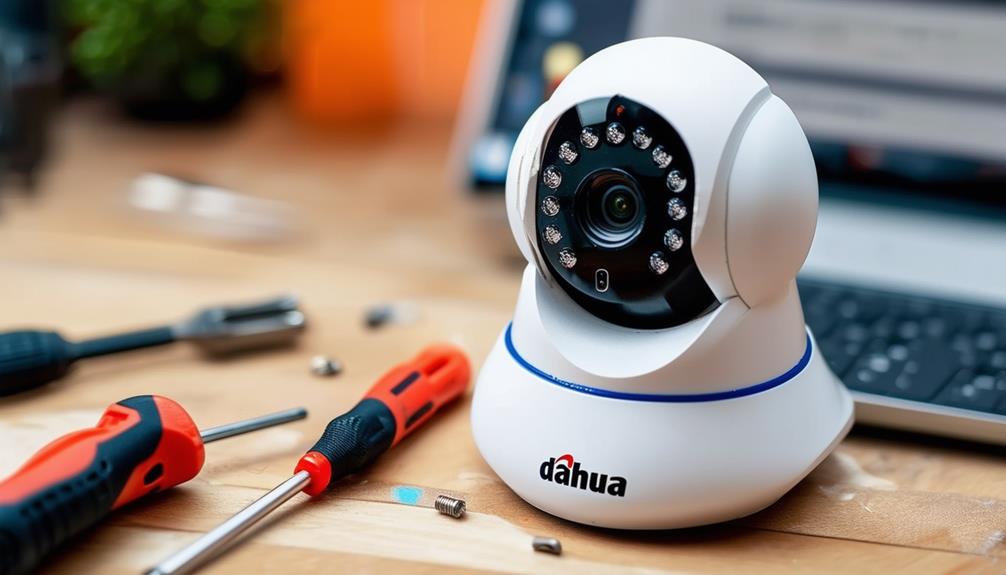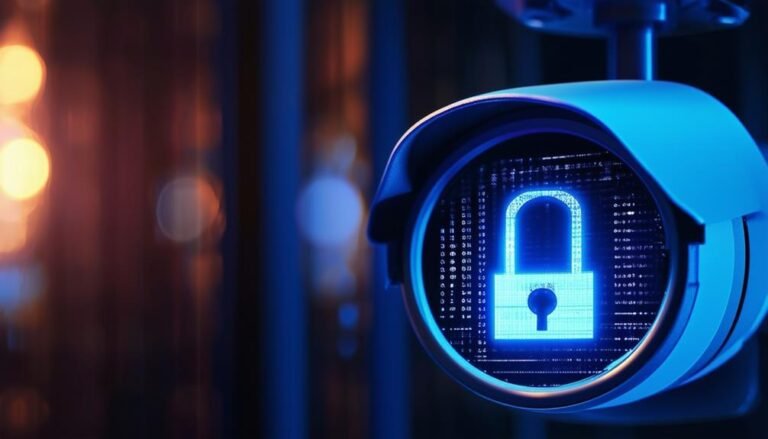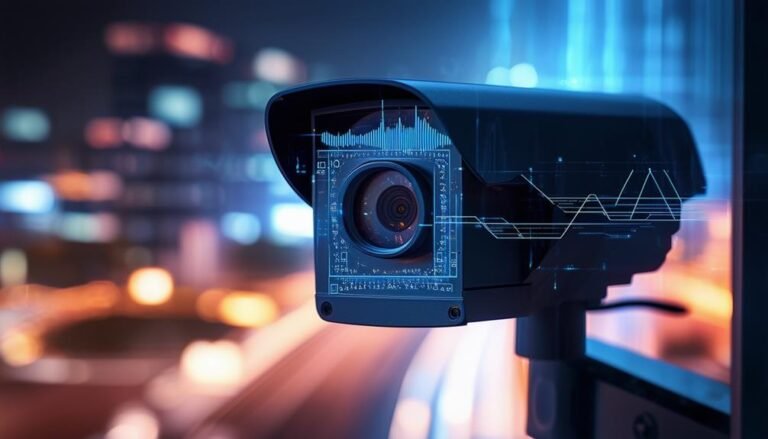Resetting your Dahua IP camera can be done easily with a couple of methods. For a soft reset, locate the reset button—usually a small pinhole—then use a paperclip to press and hold it for 10-15 seconds. This keeps your settings intact and fixes minor glitches. If you're facing significant issues, perform a hard reset by holding the button for the same duration, which will erase all settings. After resetting, you'll need to reconnect it to your network and adjust configurations. There's plenty more you can do to optimize your camera, so let's keep going!
Understanding the Reset Options
When it comes to resetting a Dahua IP camera, understanding the available reset options is crucial. You've got a couple of choices at your fingertips, whether you're dealing with minor glitches or more significant issues. Knowing these options can empower you to regain control over your security setup.
The first option is a soft reset. This process usually involves accessing the camera's web interface. By logging in with your credentials, you can navigate to the settings menu and find the reset option. This method allows you to keep your configurations intact while resolving minor connectivity or performance issues. It's a straightforward way to guarantee your camera continues to function effectively without losing your custom settings.
If you're facing more stubborn problems or need a complete overhaul, you might consider a hard reset. This typically involves pressing a physical reset button on the camera itself. You'll want to press and hold this button for a specific duration, usually around 10 seconds. This action wipes all settings and returns your camera to its factory defaults, giving you a fresh start. While this can feel drastic, it's often necessary for reclaiming full functionality.
Whichever option you choose, understanding these reset methods equips you to tackle issues proactively. You're not just fixing a problem; you're reclaiming your freedom to manage your surveillance system as you see fit.
Preparing for the Reset Process
Before diving into the reset process, it's important to gather everything you'll need for a smooth experience. First off, make certain you have your Dahua IP camera nearby and connected to a power source. It's vital to have a stable environment so you can focus on the task at hand without interruptions.
Next, grab a small, pointed tool like a paperclip or a pin. You'll need this to access the reset button, which is often tucked away in a small hole on the camera's body. Having a flashlight handy can also be helpful, especially if the reset button isn't easily visible.
Don't forget to have your network details ready. If you're planning on setting the camera up again after the reset, note down your Wi-Fi name and password. This will save you time and hassle later on. Also, make sure you have any relevant software or apps installed on your computer or smartphone, as you may need them for reconfiguration post-reset.
Lastly, it's a good idea to back up any important footage or settings if possible before resetting. You wouldn't want to lose valuable data during this process. By preparing all these elements in advance, you'll empower yourself to handle the reset confidently, knowing that you're fully equipped for what's next. Freedom from technical hassles is just a reset away!
Performing a Soft Reset
Sometimes, a soft reset is all you need to get your Dahua IP camera back on track without losing any settings. This process is simple and can often resolve connectivity issues, glitches, or minor bugs that might be causing problems. You won't have to worry about reconfiguring your camera from scratch.
To perform a soft reset, start by locating the reset button on your camera. It's usually a small pinhole, so you'll need a paperclip or a similar tool. Once you've found it, make sure your camera is powered on. Then, gently press and hold the reset button for about 10 to 15 seconds. You should see the LED indicators on your camera flicker, which means the reset process is underway.
After you release the button, give your camera a moment to reboot. Once it's back up, check your camera's functionality. You should find that it's operating more smoothly, and all your previous settings remain intact. This method is particularly useful if you want to maintain your custom configurations while still revitalizing the camera's performance.
Performing a Hard Reset
If your Dahua IP camera still isn't functioning properly after a soft reset, a hard reset might be necessary. This process will restore your camera to its factory settings, wiping out any previous configurations. It's a straightforward procedure, but you'll want to verify you're ready to set everything back up afterward.
To perform a hard reset, locate the reset button on your camera. This button is usually found on the back or bottom of the device. You might need a paperclip or a similar object to press it. Once you've got your tool, power on the camera. After it's powered up, press and hold the reset button for about 10 to 15 seconds. You'll notice the camera's indicator lights flicker or change, signaling that the reset process has begun.
After you release the button, give the camera a few moments to complete the reset. It'll reboot itself and return to its original factory settings. At this point, all customized settings, including Wi-Fi configurations and user accounts, will be erased, granting you a clean slate.
It's a powerful way to regain control over your device, especially if you value the freedom of setting it up just the way you want. Remember, a hard reset is a last resort; use it wisely. Once you're done, you're ready to start fresh with your camera!
Configuring the Camera After Reset
After resetting your Dahua IP camera, you'll want to configure it to suit your needs. Start by connecting your camera to your network. You can do this using an Ethernet cable or via Wi-Fi, depending on your model. Make sure your camera is powered on and connected properly.
Next, access the camera's settings through a web browser. Enter the camera's default IP address, usually found in the user manual. You'll be prompted to log in; use the default credentials, often "admin" for both username and password. Once logged in, change these credentials immediately to secure your camera.
Now, navigate to the network settings to assign a static IP address if you prefer. This helps avoid connection issues later. Configure the camera's resolution, frame rate, and bitrate to balance quality and bandwidth according to your preferences.
Don't forget to set up motion detection and alerts. This feature can provide you with real-time notifications, enhancing your sense of security. Customize the recording settings as well, deciding whether you want continuous recording or event-triggered recording.
Frequently Asked Questions
What Are the Indications That My Dahua Camera Needs a Reset?
If you're noticing your Dahua camera's acting up, it might be time for a reset. Indications include frequent disconnections, blurry images, or failure to respond to commands. You might also find that the camera doesn't save settings or gets stuck in a boot loop. If you can't access the live feed or the app, that's another sign. Trust your instincts—if it feels off, it probably needs a reset!
Can I Reset My Dahua Camera Remotely?
Yes, you can reset your Dahua camera remotely, but it depends on the camera's settings and network accessibility. If you've got administrative access, you can usually perform a reset through the camera's web interface or associated app. Just navigate to the settings menu and look for the reset option. However, keep in mind that remote resets might not resolve all issues, and sometimes a physical reset is necessary for more stubborn problems.
Will Resetting Erase All Recorded Footage?
Will resetting really wipe all your recorded footage? It's a common concern, and the answer depends on your device's settings. Generally, a reset restores factory defaults but won't erase your footage stored on an external drive or cloud. However, it's always wise to back up your important recordings before making any changes. That way, you can enjoy the freedom of knowing your data's safe while you manage your camera's settings confidently!
How Do I Find My Camera's Default Login Credentials After Reset?
After resetting your camera, you'll need its default login credentials to access it. Typically, you can find this information in the user manual or on the manufacturer's website. If you don't have the manual, searching for your camera model online can lead you to the right info. Often, the default username is "admin" and the password might be "123456" or blank. Always change these after logging in for security!
Is There a Warranty Impact if I Reset My Camera?
Resetting your camera can feel like hitting the refresh button on your tech life. Generally, a factory reset won't void your warranty, as long as you haven't tampered with the hardware. However, it's wise to check your specific warranty terms, since some manufacturers have unique stipulations. If you're unsure, reaching out to customer support can clear things up and keep your peace of mind intact while you explore your device's potential.



